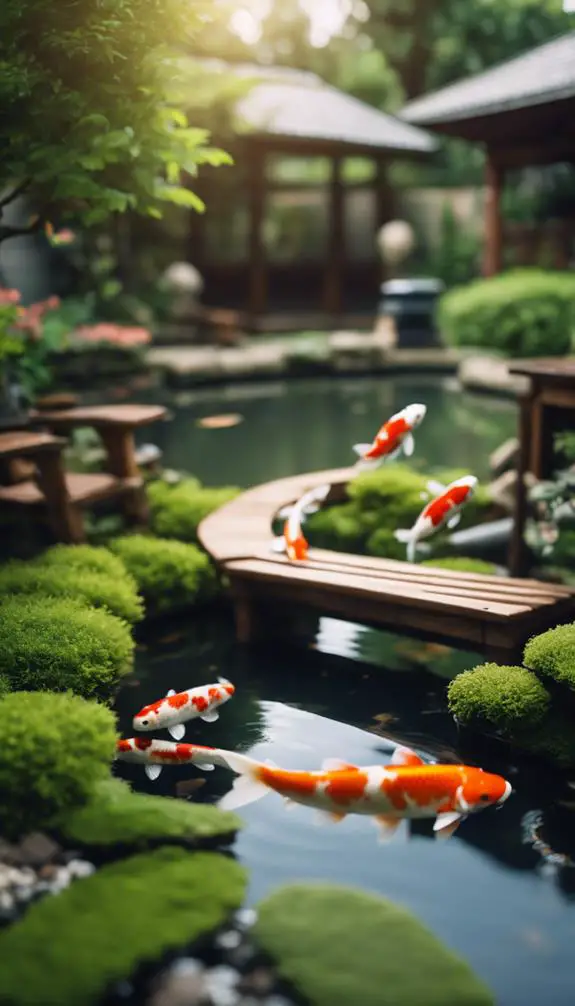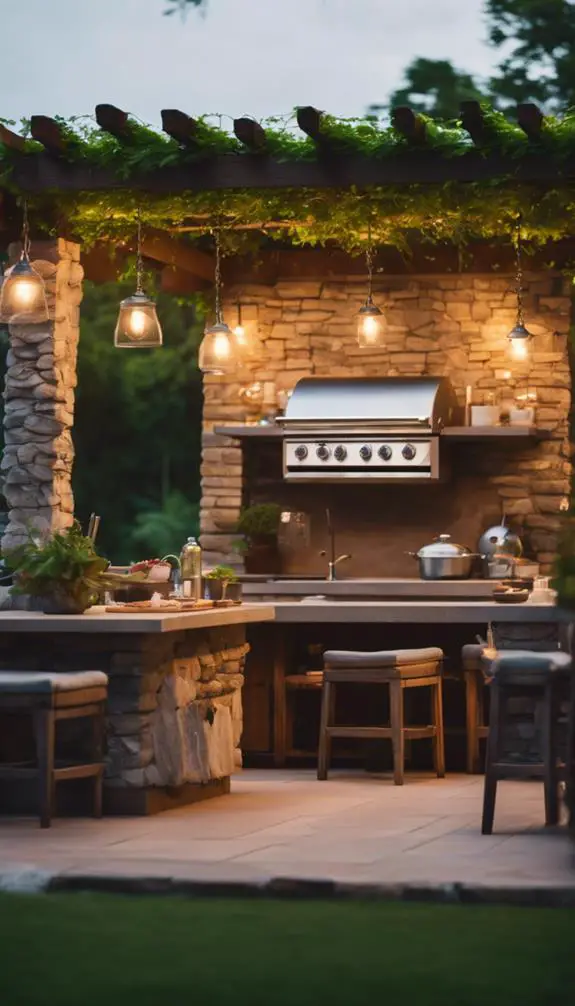As you envision your ideal outdoor kitchen, you're likely picturing a space where you can effortlessly host gatherings, cook up a storm, and soak up the sunshine. But before you start building, it's vital to lay the groundwork. You'll need to pinpoint your personal style, assess your yard's potential, and select the perfect grill station to anchor your design. With so many possibilities, it can be overwhelming – but don't worry, we're about to break it down for you. Let's get started and uncover the essential elements that'll transform your backyard into a culinary haven.
Summary
- Define your outdoor kitchen style early on to guarantee a cohesive look and ensure a well-designed space.
- Assess your yard's shape, slope, and unique characteristics to create a functional and innovative outdoor kitchen design.
- Choose the right grill station by considering essentials like countertops, storage, and lighting, as well as fuel type and available utilities.
- Select durable, weather-resistant materials like stainless steel, recycled plastic, and sustainably harvested wood to guarantee longevity and sophistication.
- Budget planning is essential to guarantee your outdoor kitchen vision becomes a reality, so create a detailed estimate and allocate 10-15% for unexpected expenses.
Defining Your Outdoor Kitchen Style
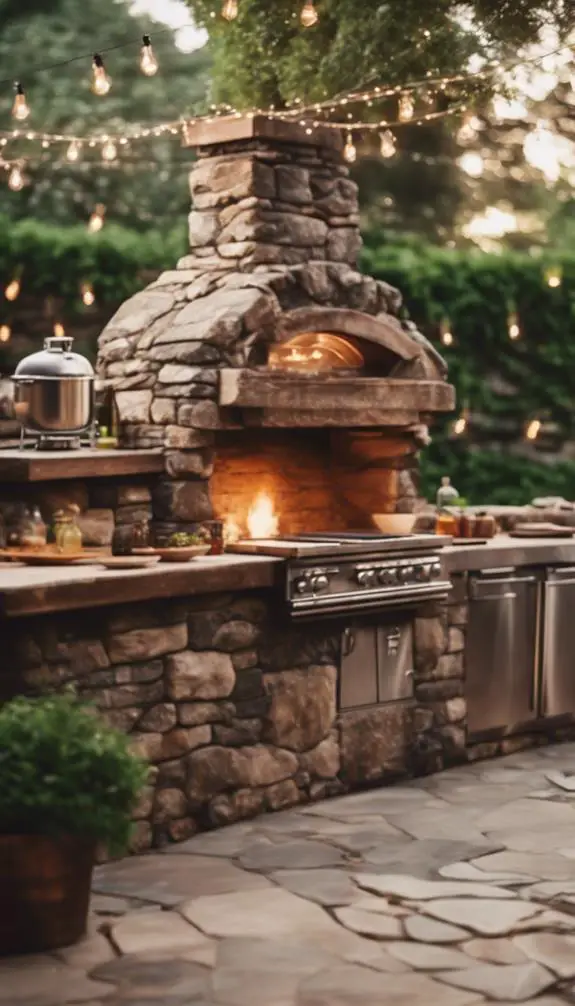
As you envision your outdoor kitchen, a few distinct styles likely come to mind.
You might picture a sleek, modern space with clean lines and minimalist decor, or a cozy, rustic retreat with natural stone and reclaimed wood accents.
Perhaps you're drawn to coastal vibes, with crisp whites, blues, and sandy neutrals evoking the feeling of a seaside escape.
Or maybe rustic charm is more your speed, with earthy tones and organic textures that bring the outdoors in.
Whatever your style, it's crucial to define it early on to guarantee your outdoor kitchen design stays true to your vision.
Consider the architecture of your home, your personal taste, and the surrounding landscape to narrow down your options and create a cohesive look.
Assessing Your Yard's Potential
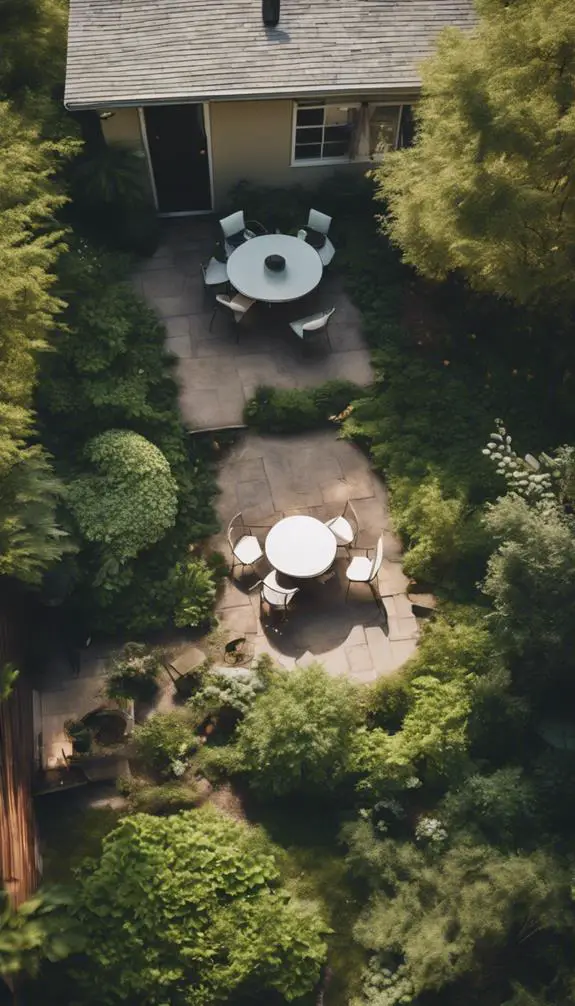
Beyond your style, your yard's unique characteristics will substantially influence your outdoor kitchen's design.
You'll need to assess your yard's potential by analyzing its shape and slope. Does your yard slope upward or downward? This will impact the placement of your outdoor kitchen components and the overall flow of your space.
Is your yard narrow and rectangular or wide and circular? This will influence the layout and functionality of your outdoor kitchen.
Consider how these factors will affect the traffic flow, seating areas, and overall usability of your outdoor kitchen. By understanding your yard's unique characteristics, you can create an innovative and functional outdoor kitchen that complements your space and meets your needs.
Choosing the Right Grill Station
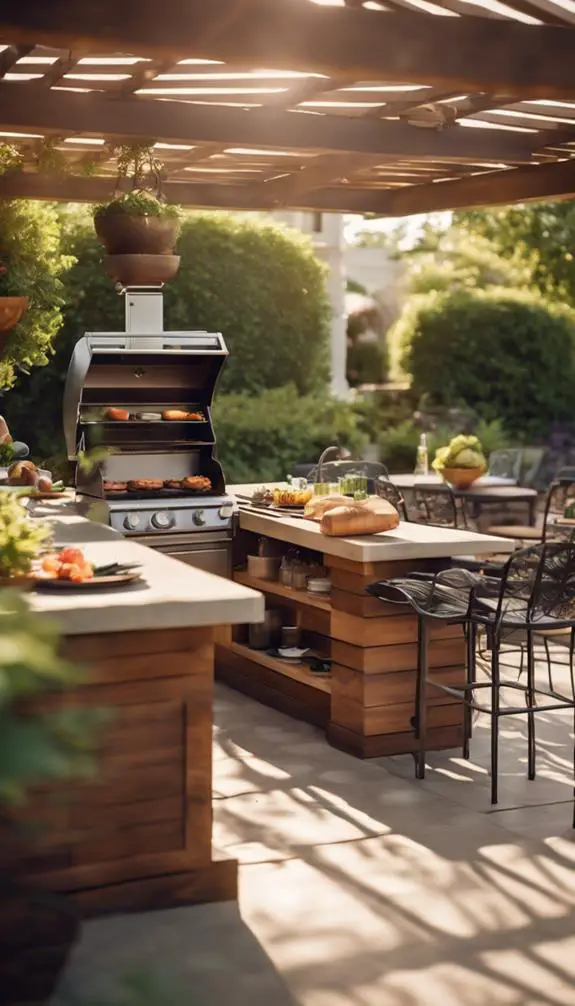
As you envision your outdoor kitchen, consider what grill station essentials you need, such as countertops, storage, and lighting, to create a functional cooking space.
Think about the grill size and space you have available – will a compact grill fit snugly into a corner, or do you have room for a larger, island-style station?
With fuel type options ranging from gas to charcoal to electric, you'll want to choose the one that best suits your cooking style and available utilities.
Grill Station Essentials
Frequently, the centerpiece of an outdoor kitchen is the grill station, where the magic happens and memories are made.
When designing your grill station, consider your grill station goals: what do you want to achieve with this space? Do you envision a cozy gathering spot or a sleek, modern hub for foodie experimentation?
Your outdoor decor should reflect this vision, with materials, colors, and textures that harmonize with the surrounding landscape. Essential elements include a sturdy grill base, ample counter space, and clever storage solutions for utensils, seasonings, and fuel.
Grill Size and Space
With your grill station goals in mind, you're now ready to tackle the fundamental question: what size grill will best serve your outdoor kitchen?
Consider the physical space where your grill will reside. Think about the island placement and how it will interact with the surrounding area.
Grill dimensions play a vital role in determining the overall aesthetic and functionality of your outdoor kitchen. A larger grill may provide more cooking space, but it may also overwhelm the island and compromise workflow.
Conversely, a smaller grill might be more suitable for compact spaces, but it may limit your cooking capabilities. Carefully calculate your needs to strike a balance between form and function.
Fuel Type Options
Pinpoint your perfect grill station by homing in on the fuel type that suits your outdoor kitchen style.
When it comes to fuel options, you've got two primary choices: propane and natural gas. Propane pros include portability, ease of installation, and a lower upfront cost.
Imagine a sleek, compact grill station that can be effortlessly relocated to accommodate outdoor gatherings.
On the other hand, natural gas offers its own nuances, such as a cleaner-burning fuel source and lower operating costs in the long run.
Envision a sophisticated, built-in grill station that seamlessly integrates with your outdoor kitchen's sleek lines and modern aesthetic.
Essential Appliances and Features

Surrounded by lush greenery, your outdoor kitchen comes alive with the essential appliances and features that transform it into a functional culinary space.
As you step into this inviting area, you're greeted by the sleek lines of outdoor refrigeration units, carefully chosen to keep your beverages and ingredients chilled to perfection.
Nearby, an outdoor sink awaits, its durable construction and stylish design making food prep and cleanup a breeze.
These must-haves are thoughtfully integrated into the space, creating a seamless flow between cooking, entertaining, and relaxation.
With these essential appliances and features, your outdoor kitchen becomes an extension of your indoor living space, perfect for hosting gatherings and making unforgettable memories.
Designing for Flow and Function

As you envision your outdoor kitchen, you'll likely find yourself traversing multiple zones, from food prep to cooking to dining.
To guarantee a seamless experience, consider the flow of traffic paths between these outdoor zones. Imagine the trajectory of your guests as they move from the grill to the dining area, or from the bar to the lounge seating.
Strategically place key features, like countertops and storage, to minimize congestion and maximize functionality. By designing with flow in mind, you'll create an outdoor kitchen that's both beautiful and efficient.
Visualize the movement of people and objects through your space, and optimize your layout to create a harmonious and functional oasis.
Selecting Durable Outdoor Materials
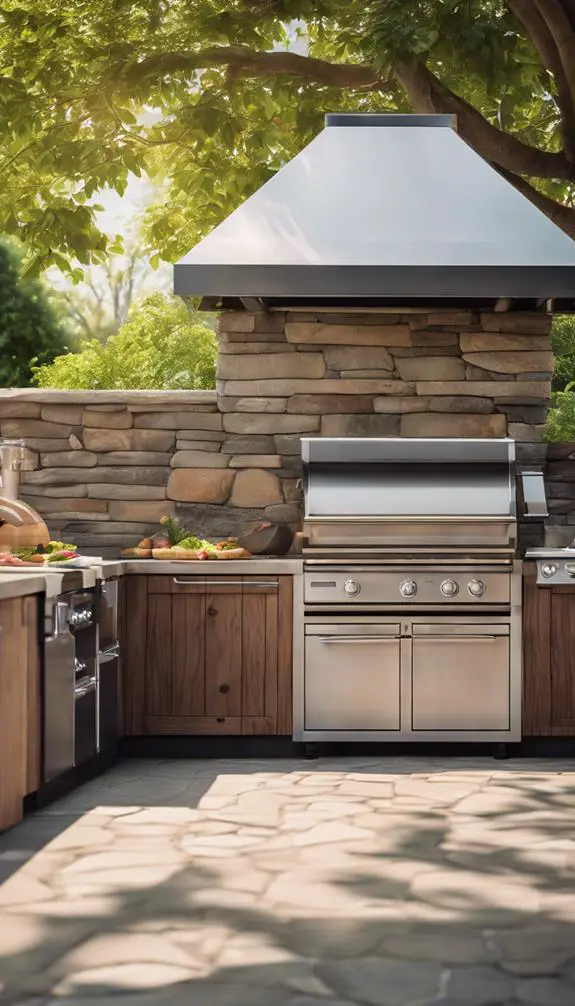
Your outdoor kitchen's durability and longevity hinge on the materials you choose.
Selecting weather-resistant materials is vital to guarantee your space remains functional and visually appealing for years to come. Consider sourcing materials that can withstand harsh weather conditions, such as stainless steel, recycled plastic, or sustainably harvested wood.
These materials won't only provide a durable foundation but also add a touch of sophistication to your outdoor space. When selecting materials, think about the spatial layout of your kitchen and how each element will interact with the environment.
Adding Ambiance With Lighting
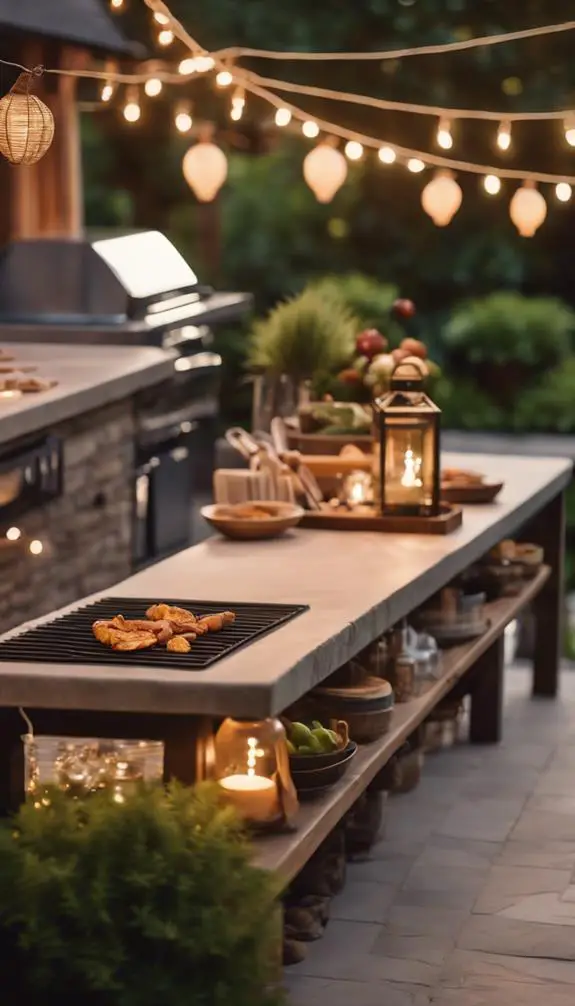
With your durable materials in place, it's time to think about the ambiance you want to create in your outdoor kitchen.
You want to craft an atmosphere that invites relaxation and entertainment. Soft lighting is key to achieving this warm ambiance. Strategically place table lamps, floor lamps, or string lights to create pools of warm light.
This will define different areas within your outdoor space, making it feel cozier and more intimate. Consider hanging lanterns or pendant lights above your dining or cooking areas to create a sense of enclosure.
Creating a Functional Layout
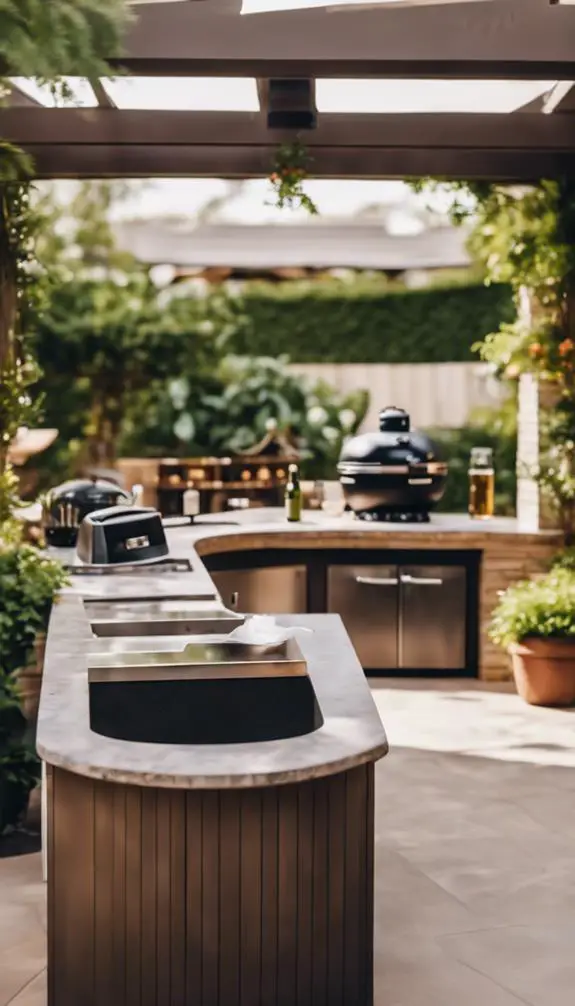
Frequently, outdoor kitchens fall short on functionality, sacrificing style for substance.
When designing your outdoor kitchen, focus on creating a functional layout that streamlines cooking and entertaining.
Divide the space into functional zones, such as a cooking station, prep area, and dining space.
Consider the traffic patterns you'll create, ensuring there's enough room to move between zones without congestion.
Position your grill, countertops, and storage thoughtfully to minimize walking distances and maximize efficiency.
As you visualize the flow of your outdoor kitchen, think about how you'll move through the space, and design accordingly.
Incorporating Storage and Countertops
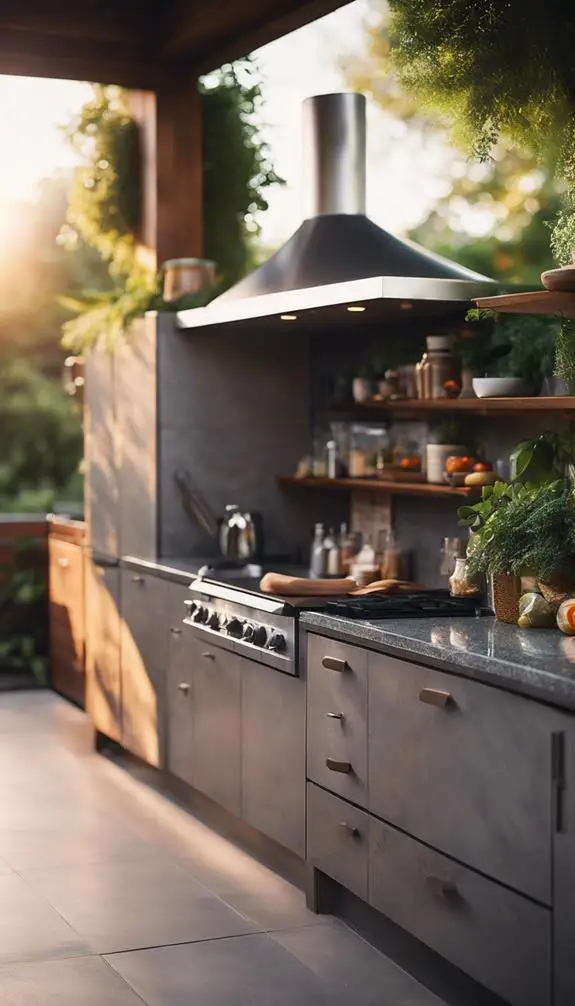
As you design your outdoor kitchen, you'll need to balance functionality with aesthetics, and that's where clever storage and countertops come in.
You'll want to weigh compact cabinet solutions that maximize space, durable countertop materials that can withstand the elements, and smart shelving ideas that keep essentials within easy reach.
Compact Cabinet Solutions
Compact cabinet solutions cleverly integrate storage and countertops, allowing you to maximize every inch of your outdoor kitchen space.
When designing your outdoor kitchen, every square foot counts, and space savers like corner cabinets can make a huge difference. These clever cabinets fit snugly into tight corners, providing additional storage for utensils, seasonings, or cookware.
By incorporating countertops into the design, you'll have a seamless shift between storage and food preparation. Look for compact cabinet solutions with adjustable shelves and drawers to customize the space to your specific needs.
With smart design and clever use of space, you can create a functional and efficient outdoor kitchen that's perfect for entertaining.
Durable Countertop Materials
Your outdoor kitchen's countertops are where the action happens, and durable materials are essential to withstand the elements and heavy use.
You'll want surfaces that can resist scratches, cracks, and fading from sunlight. Stone surfaces, like granite or bluestone, offer natural beauty and exceptional durability.
For a more modern look, consider concrete overlays, which can be stained or painted to match your outdoor kitchen's aesthetic.
These materials will hold up to spills, heat, and heavy traffic, ensuring your countertops remain functional and stylish for years to come. With the right durable materials, you can create a beautiful, high-performance outdoor kitchen that's perfect for entertaining and cooking up a storm.
Smart Shelving Ideas
Beyond the countertops, smart shelving ideas can elevate your outdoor kitchen's functionality and style by incorporating storage and countertops seamlessly.
You can maximize corner spaces with corner shelves that provide easy access to frequently used items. Adjustable rails allow you to customize shelf heights according to your needs, ensuring efficient storage and display of cookware, utensils, and dinnerware.
Consider installing shelves with built-in countertops, creating a smooth shift between storage and food preparation areas. This design fusion will streamline your outdoor kitchen's workflow, making meal prep and cleanup a breeze.
Budgeting for Your Dream Kitchen
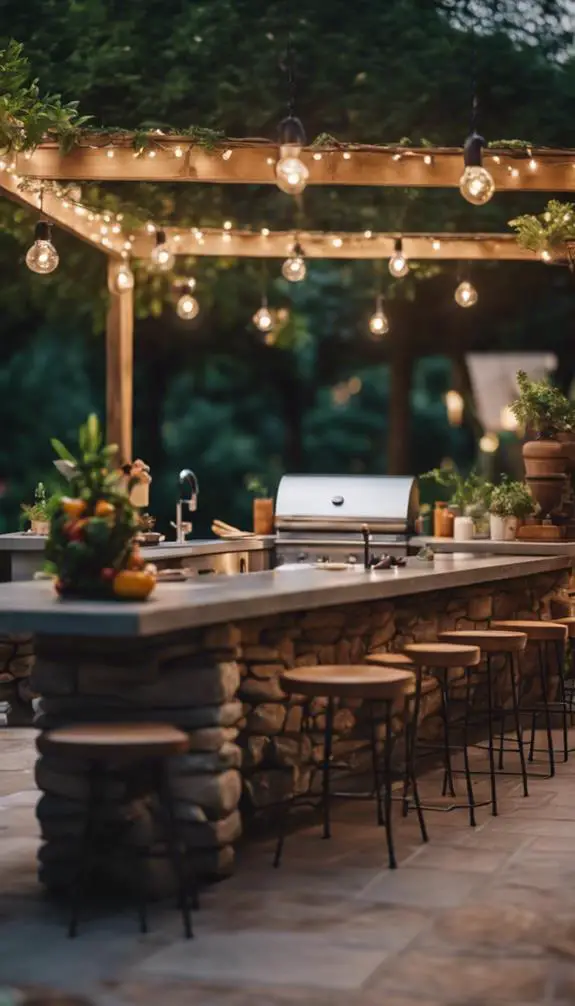
Every outdoor kitchen project starts with a pivotal question: how much are you willing to invest in your dream space?
Budget planning is essential to guarantee your vision becomes a reality. You'll need to ponder costs like appliances, countertops, and flooring, as well as labor and installation fees.
Create a detailed estimate by breaking down your project into smaller components, and research costs for each item. Cost estimating tools or online resources can help you get started.
Ponder allocating 10-15% of your budget for unexpected expenses. By setting a realistic budget, you'll be able to prioritize your must-haves and make compromises on nice-to-haves, resulting in an outdoor kitchen that meets your needs and stays within your means.
DIY Vs Professional Installation

With your budget in place, it's time to ponder the next critical decision: who'll bring your outdoor kitchen to life?
You have two options: DIY or professional installation. If you're short on time, a professional installation might be the way to go. They'll handle everything from design to execution, ensuring your outdoor kitchen is completed efficiently.
On the other hand, if you're on a tight budget, DIY might be the more cost-effective option. However, be aware that DIY installations can be time-consuming and may require sacrificing some of the finer details.
Consider your time constraints and budget constraints carefully before making a decision. Will you opt for speed and convenience or try to save a buck by going solo?
Maintenance and Upkeep Tips

As you step into your newly built outdoor kitchen, the sizzle of the grill and the chatter of guests create an inviting atmosphere.
To keep this ambiance intact, regular maintenance is vital. Start by performing seasonal cleaning, paying attention to areas prone to debris accumulation, like countertops and grout lines.
Before winter, prep your outdoor kitchen by covering or storing sensitive items, like outdoor furniture and decor, to protect them from harsh weather conditions.
Winter prep also includes cleaning and covering your grill, as well as inspecting and repairing any damaged outdoor structures.
FAQs
Can I Add an Outdoor Kitchen to a Small Yard or Balcony?
You can creatively overcome space constraints by optimizing your yard's layout, using vertical elements, and selecting multi-functional furniture, allowing you to cleverly carve out a functional outdoor kitchen, even in a small yard or balcony.
Are Outdoor Kitchens Only for Warm Weather Climates?
You're wondering if climate limitations and regional restrictions hold you back from creating an outdoor space. Not necessarily! While warm weather climates are ideal, innovative designs and materials can adapt to cooler or wetter regions, allowing you to extend your outdoor living season.
Do Outdoor Kitchens Increase a Home's Resale Value?
When you invest in strategic property upgrades, like outdoor kitchens, you're not just enhancing your living space – you're boosting your home's resale value, making it a standout in the market, and reaping the benefits of smart home staging.
Can I Use My Outdoor Kitchen During the Winter Months?
You can extend your outdoor living season by winterizing your space with extreme weatherization measures, such as insulated roofs, heaters, and windbreaks, allowing you to enjoy winter usage, even on chilly days, in a cozy, protected area.
Do I Need to Hire a Professional for Electrical Installations?
When tackling electrical installations, you'll need to navigate complex electrical codes and permit requirements, ensuring your setup is safe and compliant; consider hiring a pro to guarantee a seamless, innovative setup that meets local regulations and your unique spatial needs.
Conclusion
You've envisioned the perfect outdoor kitchen, and now it's time to bring it to life. Encompass your newly defined style, carefully assessed yard, and thoughtfully chosen grill station with essential appliances and features. With a functional layout, ample storage, and weather-resistant materials, your outdoor oasis is ready to shine. By budgeting wisely, considering professional installation, and prioritizing maintenance, you'll be cooking up memories for years to come, surrounded by the beauty and functionality you've carefully crafted.


